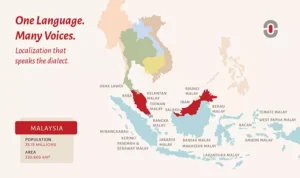AI Overview
| Category | Summary |
| Topic | Dialect-specific localization strategies for Malay-speaking Southeast Asia |
| Purpose | To help brands understand how dialectal nuances in Malay impact localization success across Malaysia, Brunei, and Singapore — and how to adapt messaging accordingly |
| Key Insight | Even within one language, dialectal differences in tone, vocabulary, and cultural norms significantly affect message clarity and audience engagement — failing to localize for dialect risks miscommunication and brand alienation |
| Best Use Case | For global companies entering or scaling across Southeast Asian markets where Malay is spoken — especially in marketing, UX content, and digital products |
| Risk Warning | Using Standard Malay across all regions can result in tone-deaf messaging, low engagement, and loss of trust, particularly in culturally distinct areas like Sarawak or Brunei |
| Pro Tip | Assign native linguists from each region and include cultural consultants in the workflow — then validate messaging through A/B testing and user feedback to optimize tone and cultural fit |
Southeast Asia is home to over 690 million people, and among its many languages, Malay plays a central role. Spoken by more than 290 million people across Malaysia, Brunei, Singapore, and parts of Indonesia, Malay isn’t just one language — it’s a diverse web of dialects shaped by geography, history, and culture. For global businesses expanding into these fast-growing markets, recognizing this dialectal diversity is not just smart — it’s critical.
In 2021, a well-known beauty brand launched a campaign in Malaysia using Standard Malay. While the grammar was technically correct, sales in East Malaysia lagged. Feedback showed that audiences in Sarawak found the language overly formal and emotionally distant. What was meant to sound aspirational came across as foreign. The brand had inadvertently alienated a key segment by failing to localize for dialect and tone.
This misalignment wasn’t due to poor translation — it was due to insufficient localization. The campaign didn’t account for the regional dialectical differences that shape how Malay speakers relate to language, tone, and messaging.
In markets like Malaysia, Brunei, and Singapore, effective communication in Malay isn’t about translating the message — it’s about translating the meaning behind the message. And that requires a deeper understanding of dialects, culture, and context.
The Linguistic Complexity of Malay: One Language, Many Voices
At first glance, Malay may seem unified. After all, Bahasa Melayu is the official language of Malaysia and Brunei, and recognized in Singapore. However, regional dialects such as Kelantanese, Sarawakian, and Bruneian Malay differ significantly in vocabulary, pronunciation, and even grammar.
Let’s take a deeper view in these Malay dialects in practice:
- Kelantanese Malay (Bahasa Kelantan) is often unintelligible to speakers from other parts of Malaysia. It’s characterized by shortened words and a rhythmic cadence that often renders it incomprehensible to non-locals. Brands relying on Standard Malay may be misunderstood — or completely ignored — by Kelantanese audiences.
- Sarawak Malay integrates Dayak and Iban influences and employs distinct sentence structures. A phrase that works in Peninsular Malaysia might lose clarity — or cultural meaning — in Kuching.
- Bruneian Malay (Bahasa Melayu Brunei) features different expressions and social norms around tone and politeness. For example, it tends toward indirectness and subtlety in marketing language — a major contrast with the more direct tone common in West Malaysian advertising.
Mishandling these linguistic nuances carries risks. A phrase that works in one dialect may come across as tone-deaf, culturally insensitive, or just irrelevant in another. In a region where cultural respect and tone are paramount, this can undermine trust, reduce engagement, and damage brand reputation.
Beyond Translation: The Case for Dialect-Specific Localization
Localization is more than swapping words between languages. It’s the practice of adapting content to reflect local linguistic, cultural, and behavioral expectations. This includes tone, idioms, humor, and even levels of formality. In a multilingual and multi-dialectal region like Southeast Asia, generic content can quickly feel tone-deaf.
At 1-StopAsia, we specialize in dialect-specific localization that accounts for regional linguistic behaviors and cultural context. We approach Malay dialects localization as a layered task and this is how we do it:
1. Native Linguists with Dialect Expertise
Every localization project is assigned to linguists who are native speakers of the target dialect. Each task is entrusted to a linguist who understands not only the language, but also the mindset of the local audience.
2. Cultural Consultants for Market Fit
Beyond linguistic accuracy, 1-StopAsia integrates cultural review into the localization process to ensure content resonates within the specific socio-cultural context of each market. Native linguists — often supported by regional subject-matter experts — assess the subtleties of tone, politeness levels, visual symbolism, and phrasing. This step goes beyond language to ensure the message reflects the values, sensitivities, and norms of the target audience.
3. Iterative Testing and Validation
A/B testing and user feedback loops are built into our localization workflow. Messages aren’t just linguistically correct — they’re tested for emotional resonance and behavioral impact. This way localization becomes a dynamic process — refined based on real user data to optimize engagement.
Malaysia vs. Brunei: A Tale of Two Tones
In Malaysia, especially urban Peninsular areas, marketing content often uses a semi-formal yet enthusiastic tone. By contrast, Bruneian consumers may interpret such exuberance as pushy or insincere. Brunei’s strong Islamic culture and social etiquette demand a gentler, more respectful communication style. This affects everything from how you describe a product’s benefits to how you issue a call to action.
Ignoring these nuances can damage brand credibility. Addressing them can significantly enhance engagement.
Case Example: Adapting for Bruneian Malay
In a recent localization project, 1-StopAsia partnered with a Brunei-based e-commerce startup looking to optimize user engagement. The initial site content was written in Standard Malay, adapted from materials used in Malaysia.
Problem Identified:
Users found the language stiff and overly distant to users. Bounce rates were high, and promotional email open rates were below industry benchmarks.
- Rewrote product descriptions using Bruneian Malay expressions with softer, more relational phrasing.
- Shifted tone from direct imperatives (“Buy now!”) to more culturally acceptable suggestions (“Explore what suits you best”).
- Conducted A/B testing with local users to refine phrasing and tone across core web pages.
Results:
- Engagement on key landing pages increased by 18% over three months.
- Customer feedback praised the “natural and friendly” tone of the site.
- Repeat visit rates improved, showing deeper user connection.
This success was powered by native Bruneian linguists and local cultural consultants who ensured every sentence aligned with audience expectations. Their expertise transformed a formal translation into a warm, regionally-appropriate user experience.
Why This Matters for Global Brands
Southeast Asia is not a monolith. Its cultural and linguistic complexity demands localized strategies that reflect on-the-ground realities. As markets like Malaysia and Brunei grow in digital literacy and consumer sophistication, generic messaging becomes increasingly ineffective.
Missteps in localization not only cost money — they can damage brand reputation. On the other hand, culturally-tuned content fosters trust, drives engagement, and creates authentic brand relationships.
Final Thoughts: Precision Is Power in Southeast Asia
For localization managers, exporters, and product teams targeting Malay-speaking regions, understanding dialectal differences isn’t just a nice-to-have. It’s an essential component of successful market entry and growth.
Whether launching an app in Malaysia, promoting a product in Brunei, or scaling services across ASEAN, linguistic and cultural nuance will define how your message lands.
At 1-StopAsia, we combine native fluency with strategic cultural insight — delivering tailored Malay localization services that empower your global vision.
Looking to make your next Malay-language project resonate? Reach out to 1-StopAsia and explore how dialect-specific localization can elevate your brand.

